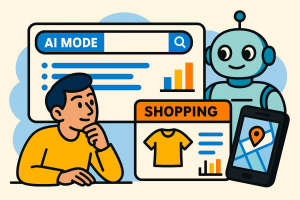 Google is moving full steam ahead with AI integration in Search, whether users are ready for it or not. After a rocky debut last year, its AI Overviews have returned with a new feature in tow: AI Mode. Live for U.S. users following the company’s 2025 I/O event, this new tab aims to radically alter how people interact with search results.
Google is moving full steam ahead with AI integration in Search, whether users are ready for it or not. After a rocky debut last year, its AI Overviews have returned with a new feature in tow: AI Mode. Live for U.S. users following the company’s 2025 I/O event, this new tab aims to radically alter how people interact with search results.
AI Mode introduces a more conversational interface that mimics tools like ChatGPT. It’s built to handle layered, complex queries, parsing out multiple topics and drawing on a wide range of sources to deliver synthesized answers. The system uses what Google calls a “query fan-out” approach—breaking a question into parts, running simultaneous searches, and stitching the findings together into one long-form reply. Answers include sources and are presented with summaries, sometimes even visual data.
The company says this approach cuts down on the need for repeat searches. A sample query might ask how sleep-tracking features differ across rings, watches, and mats. Instead of requiring three separate searches, AI Mode aims to generate a full comparison in one go—complete with supporting data and source links.
More features are on the way. AI Mode will soon upgrade to Gemini 2.5, Google’s latest large language model. Google claims this update will boost the quality of responses, assuming users were already running the older Gemini 2.0 engine. In addition, a feature called Deep Search is launching. It’s designed to run extensive background searches and compile results into a report, graphs included where relevant.
Another upcoming addition: agent-style tools. These features will allow the system to take actions on behalf of users. One example from Google’s demo included booking event tickets, with the AI not only finding the options but also filling in forms for checkout. Google says this could reduce multi-step tasks to a single confirmation click.
Shopping features are also expanding. AI Mode will access Google’s “Shopping Graph,” built from over 50 billion listings. It’ll return product suggestions and even offer virtual try-on options for clothing. Down the road, the system will also pull context from users’ past searches and Gmail accounts—if users opt in—allowing for more personalized results.
The feature has moved beyond the testing stage. Anyone using Google in the U.S. may now see an “AI Mode” button next to the search bar. While some earlier testers noticed it replaced the “I’m Feeling Lucky” button, the current version appears to live alongside standard search tools.
Using AI Mode is straightforward. Just hit the button and type your question. While traditional single-topic searches still work, the platform encourages more intricate queries. Users are prompted to think bigger—combine topics, ask multipart questions, and let the AI unravel them.
Those familiar with AI-powered web tools will recognize the layout. Results are structured, broken into segments, and linked to source material. In some cases, maps or interactive widgets may appear based on the query’s nature.
Like it or not, the old search is getting shoved aside. Forget blue links—Google’s now serving up a chatbot that talks to itself and hopes you’re impressed.